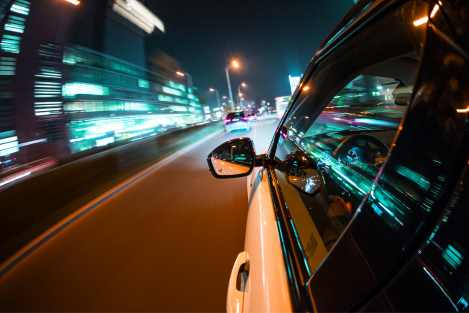
Written by Kayla Jane Barrie Updated on Mar 03, 2025 7 mins read

Driving at night can be very different than driving during the day. Many people don’t like to or have a fear of nighttime driving. Driving at night is challenging for most drivers. It can also be more dangerous.
By taking extra precautions, being alert, and being sober, we can help reduce driving accidents at night. In this blog, we’ll provide you with 21 tips for driving at night. We’ll also answer common questions about nighttime driving.
Fatal accidents are three times more likely to occur when driving at night compared to the daytime. We can’t see as well in the dark. We see less of the road ahead, which gives drivers less time to react and stop. Although we have lights to help, they can pose hazards to other drivers by creating glare.
Studies show people have lower depth perception, peripheral vision and the ability to distinguish colour when driving at night. Driving at night can be more dangerous due to reduced visibility, distractions, and drowsiness. We only do about one-quarter of our driving at night; however, 50% of traffic deaths happen past dusk.
Day or night, you should be alert and feel confident behind the wheel. Avoiding accidents when driving at night will give you cheaper car insurance quotes in the future.
Here are 21 tips to help you feel more confident and drive safer at night :
Use your daytime lights only during the day. Night lights are mandatory in urban areas, even if it is well-lit. Turn your lights on at least 30 minutes before sunrise and sunset.
For added light, use fog lights. Use them when it’s not foggy. They have a broader spread of light compared to low beams. If your vehicle has the capability, switch your lights to auto so you don’t forget to turn them on.
Use high beams on rural and open roads when driving at night. If you see another vehicle approaching, dim them until they pass. High beams are blinding and create a severe glare for drivers. If you are behind another vehicle, don’t use high beams. High beams will increase your view to 500 feet compared to standard lights, which are 250 feet.
Make sure your windows are clear of bugs, road salt, dirt, and grease. If you have any cracks or scratches, get them fixed as soon as possible. Dirty or cracked windshields can scatter light and increase the effects of glare.
Invest in a new set of windshield wipers if the current set requires a replacement. Change the wipers about every six to eight months because they accumulate grime that will spread onto your windshield.
Carry an emergency roadside kit in your car. Ensure it has jumper cables, a first aid kit, flashlights, batteries, blankets and other materials that can help in case of an emergency. If you do break down at night, emergency kits come with lighting aids. This will ensure that you are visible to other drivers and emergency vehicles.
Dim your instrument panel and dash lights when driving at night. They can create distracting lighting inside your vehicle. Dimming them can remove reflections on your windows and windshield, allowing your eyes to adjust to the darkness ahead.
Nocturnal animals can become a hazard at night. To avoid any accidents with wildlife, look for the light reflecting in tiny bright spots ahead on the road. If you encounter a large animal, slow down as quickly as possible. Do not exit your lane or drive off the road. Animals are common around dusk and a few hours after. Be mindful when driving through forested areas and fields.
Choosing glasses with an anti-reflecting coating will prevent unnecessary light from reflecting inside the lenses and allow light to pass through. Do not buy yellow-tinted glasses. These glasses make objects and hazards more difficult to see at night because they limit the amount of light that passes through.
Avoid having a fixed gaze, and never stare at oncoming headlights when driving at night. Shift your eyes down and to the right,t and use the right edge of the road or lane markings as a guide. Once the vehicle has passed, lift your gaze back up.
When possible, take well-lit roads. Two-lane highways have low light levels, sharp turns and hills.
When driving at night, use your defensive driving instincts. Drive sober and avoid distracted driving. Be extra alert for other drivers, who might be driving irresponsibly.
Impaired driving is dangerous and can ruin lives. Do your part to keep yourself and others safe by driving sober. Driving impaired increases the risk of getting into an accident. You could also end up in jail, pay huge fines, and it affects your rates. Call a cab, get a designated driver you trust, or take public transit. There is no excuse for driving impaired.
Planning your trip ahead of time eases the stress of driving. Having a map already pulled up will limit you from distracted driving. Knowing what roads you are taking ahead of time can warn you if there is construction or any accidents on the way.
Snow, rain and fog are all factors to consider when driving in the winter. Slow down, give your vehicle space between others and stay alert to changes ahead of you.
To minimize the glare from oncoming traffic, MTO recommends looking “up and beyond slightly to the right of oncoming traffic.” Use the rearview mirror anti-glare feature to reduce the glare from cars behind you.
When driving, you should give at least two seconds to the vehicle in front of you. At night and in poor weather, you may want to double this amount.
Adjust your speed and always consider road and weather conditions. Speed-related crashes account for 37% of night driving fatalities, compared to 21% during the day. Driving at night lowers visibility and results in shorter reaction times; be mindful of your speed.
Dirty, cloudy headlamps can lower the illumination of your lights. It can comprise how far ahead you can see when driving at night. If you notice the lenses are yellowed, it’s time to restore or replace the headlamps.
Headlights can become misaligned over time. Follow your owner’s manual or consult the dealership to adjust the headlights correctly. If the lights tilt down too much, you can lose proper illumination on the road. If they tilt too high, they can cause a severe glare to oncoming drivers.
Not only does a seatbelt keep you safe, but you will avoid a ticket. If you are caught driving without a seatbelt, it could affect your rates.
Take a break every two hours when driving long distances. This will help your body and mind relax from the constant driving motion and allow you to be more alert when you get behind the wheel.
Put the phone down, take breaks and focus on the road. Avoid driving if you are feeling fatigued. When driving with distractions or drowsiness, your reaction time can be impacted. Keep your eyes on the road and check your mirrors; driving is not the time to be calling or texting.
Between midnight and 6 am, drowsy driving accidents are more likely to happen. Stay alert during these times. Take breaks, have a coffee, or stop for the night if you are feeling impacted by drowsiness when driving - day or night.
Here is what you can do to help see better when driving at night:
Rain, snow, and fog can reduce your visibility when driving at night. Here are some helpful tips to keep in mind when driving at night in bad weather.
Staying alert when driving at night is crucial to protect yourself and other drivers. Some options are better than others. Here is what you can do to stay awake when driving at night:
Glare is caused at night by the lights of oncoming vehicles that can be reflected through your windshield and mirrors. You can prevent glare from oncoming traffic by looking up and slightly beyond to the right of oncoming vehicles. Use the rearview mirror anti-glare feature to minimize the glare from cars behind you. Be considerate when you are driving with high beams.
Look up and slightly beyond to the right of oncoming vehicles to prevent glare. To minimize the glare from cars behind you, use the rear-view mirror anti-glare feature. If you use glasses, choose ones with an anti-reflecting coating to prevent unnecessary light from reflecting inside the lenses.
Practice will help you overcome fear or anxiety when driving at night. If you need to, practice with another experienced driver. Drive at the speed limit, don’t rush, put the phone down, and keep your windshield and mirrors clear. By driving in a clean, low-distraction vehicle, you can focus on the road and the cars around you.
Use the low beam night lights when you are within 500 feet of an oncoming vehicle or following a car within 200 feet. On country roads, you can use high beams, but make sure you switch to low beams when you see oncoming cars until they have passed or are approaching a car from behind. Daytime lights are not bright enough to use at night.
Yellow-tinted night driving glasses are non-prescription glasses that are advertised to minimize glare when driving at night. Don’t let the idea fool you; they are not proven to work. These glasses enhance the contrast in certain daylight conditions. However, they reduce overall visible light at night by blocking a portion of HEV blue light.
Schedule an eye exam and have your optometrist help you choose a comfortable pair that will help you drive at night. They will often suggest an anti-reflecting coating.
According to Consumer Reports, these are the best cars for night driving.
If you follow the rules of the road, drive carefully and have the proper licence to drive at night, police will not pull you over. If you are breaking any laws or driving recklessly, you can be pulled over and fined accordingly.
In Ontario, you need at least a G2 licence at night on any roadway or highway.
| Categories | Auto |
|---|---|
| Tags | Driving Tips |
Read our insurance blog to get helpful tips, information and news.
Has your car been totalled in an accident? Is your car a write off? Learn about vehicle write offs for a total loss insurance claim.
Get the facts on Toronto's auto theft problem. We break down the data, reveal the most-stolen vehicles (including the Honda CR-V and Lexus RX 350), and show which neighbourhoods are most affected.
Dive into the world of auto theft with our blog on the most stolen cars in Canada. See the most stolen cars across Canada, including provincial lists for Ontario and Quebec, and learn how high-risk models can affect your car insurance premiums.
Drive safe this winter! Check out these tips for driving in snowy and icy conditions in Ontario. Get other helpful info and FAQs on winter driving.